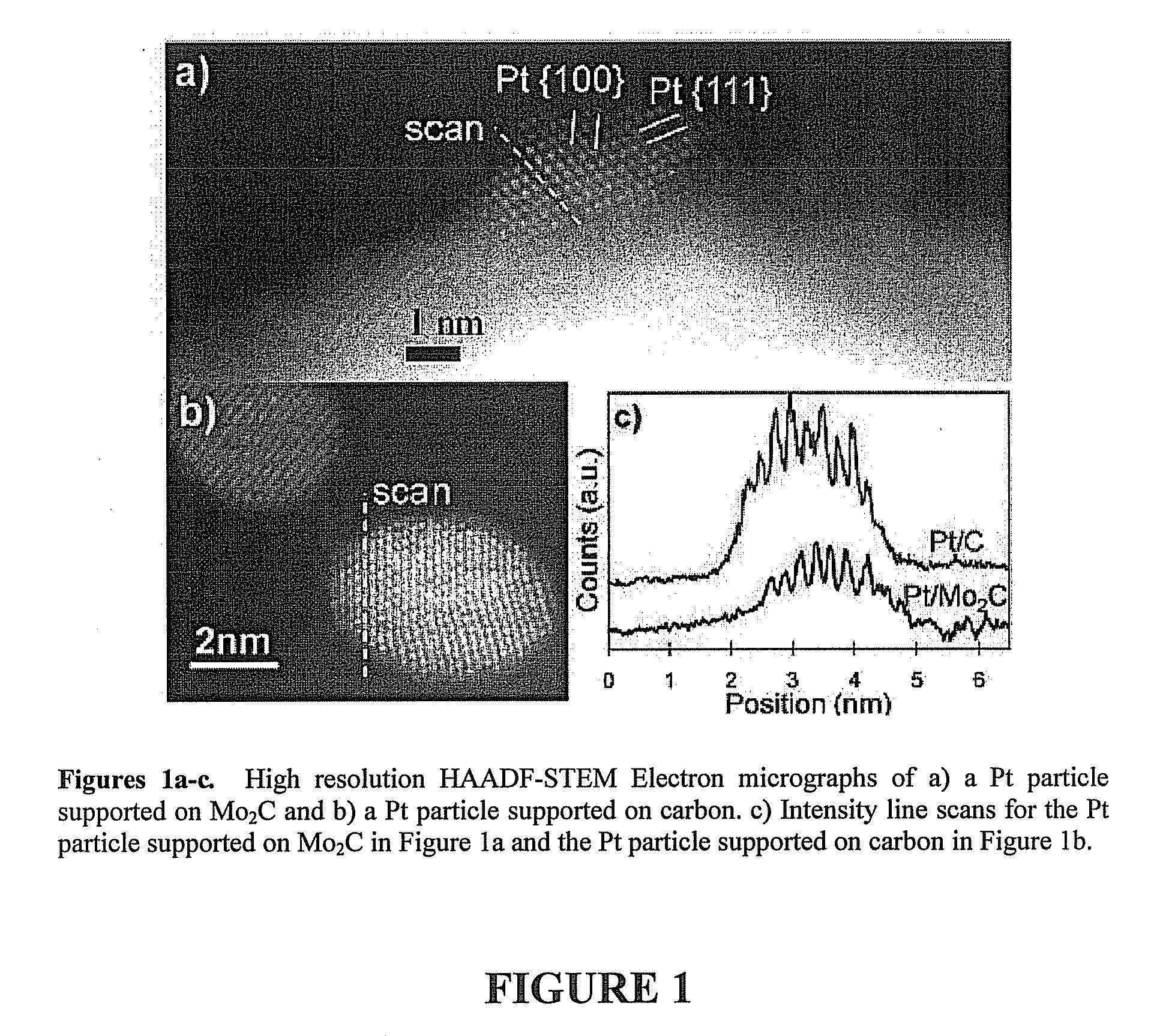High activity early transition metal carbide and nitride based catalysts
a technology of high activity and catalysts, which is applied in the direction of metal/metal-oxide/metal-hydroxide catalysts, physical/chemical process catalysts, bulk chemical production, etc., can solve the problems of reducing the overall amount of pt required (and the overall cost), and presenting certain limitations. , to achieve the effect of reducing the overall amount of pt required and the overall cos
- Summary
- Abstract
- Description
- Claims
- Application Information
AI Technical Summary
Benefits of technology
Problems solved by technology
Method used
Image
Examples
example 2
[0071]In this example, a preparation method comprises the use of an oxygen-free aqueous solution of noble metal salt according to the following steps. A temperature-programmed reaction method was used to synthesize high surface area Mo2C and Mo2N supports. This method involves reacting bulk or supported Mo oxides with a mixture of 15% CH4 in H2 or NH3 in a quartz reactor as the temperature is increased linearly. The appropriate reaction temperatures were determined based on results from thermogravimetric analysis. The resulting carbides or nitrides were carefully transferred from the synthesis reactor, without passivation or air-exposure, to vessels containing the deaerated metal salt solution. The metal concentration was adjusted to achieve the desired loading. Argon was bubbled through the solutions continuously to prevent the dissolution of O2. The mixtures were typically held at room temperature for 2 hrs and at 40° C. for 1 hr with occasional stirring. The product was then cool...
example 3
Pt—Mo2C / Al2O3 Catalyst preparation
[0072]A Mo2C / Al2O3 catalyst support was synthesized using a temperature programmed reaction procedure. Molybdate was deposited onto the Al2O3 high surface area support via incipient wetness of Al2O3 with an aqueous solution containing ammonium paramolybdate (AM, (NH4)6Mo7O24.4H2O, 81-83% MoO3, Alpha Aesar) followed by drying at 110° C. for 12 h. Approximately 1 g of the resulting AM / Al2O3 catalyst support precursor was loaded into a quartz tube reactor on top of a quartz wool plug. The AM / Al2O3 was reduced and carburized in 15% CH4 / H2 flowing at 210 mL / min as the temperature was increased from room temperature (RT) to 200′C (heating rate of 10° C. / min), and then the temperature was increased from 200° C. to 590′C at a rate of 1′C / min. The final temperature was maintained for 2 h before quenching the material to RT. The resulting material was passivated using a 1% O2 / He mixture with a flow rate of 20 mL / min for at least 5 h.
[0073]A Mo2C—Al2O3 support...
example 4
Catalyst Evaluation
[0074]Prior to the WGS and FTS reaction rate and selectivity measurements, the catalysts were pretreated in a mixture of 15% CH4 in H2, NH3 or H2 for 4 hrs at temperatures defined based on results from temperature programmed reduction analysis. The WGS rates were measured at atmospheric pressure and temperatures of 200-240° C. using a feed consisting of 9% CO, 6% CO2, 30% H2O, 39% H2, and the balance N2. The gas hourly space velocity (GHSV) ranged from 75,000 to 150,000 h−1 based on the total flow rate. The exiting gas mixture was passed through a condenser maintained at 0° C. to remove H2O, and the composition was analyzed online using a gas chromatograph equipped with a thermal conductivity detector (TCD). FIG. 9 compares WGS rates (the unlabeled ordinate) for the, Au / Mo2C, Ir / Mo2C, Cu / Zn / Al2O3 (currently used in industrial processes), and, catalysts (from bottom to top in the Figure, so that Mo2C is the least and Pt / Mo2C is the most active). Addition of the met...
PUM
| Property | Measurement | Unit |
|---|---|---|
| Fraction | aaaaa | aaaaa |
| Fraction | aaaaa | aaaaa |
| Fraction | aaaaa | aaaaa |
Abstract
Description
Claims
Application Information
 Login to View More
Login to View More - R&D
- Intellectual Property
- Life Sciences
- Materials
- Tech Scout
- Unparalleled Data Quality
- Higher Quality Content
- 60% Fewer Hallucinations
Browse by: Latest US Patents, China's latest patents, Technical Efficacy Thesaurus, Application Domain, Technology Topic, Popular Technical Reports.
© 2025 PatSnap. All rights reserved.Legal|Privacy policy|Modern Slavery Act Transparency Statement|Sitemap|About US| Contact US: help@patsnap.com



